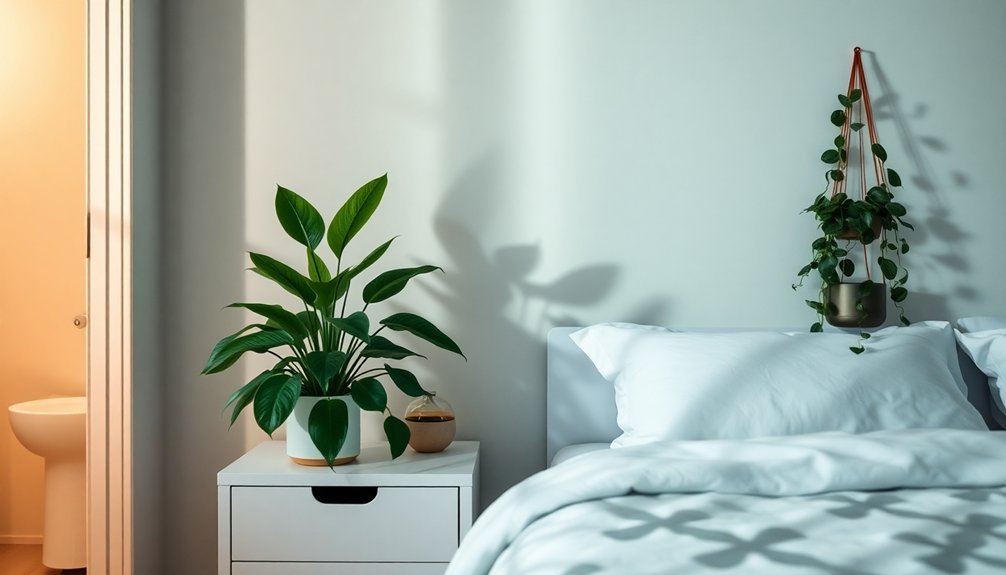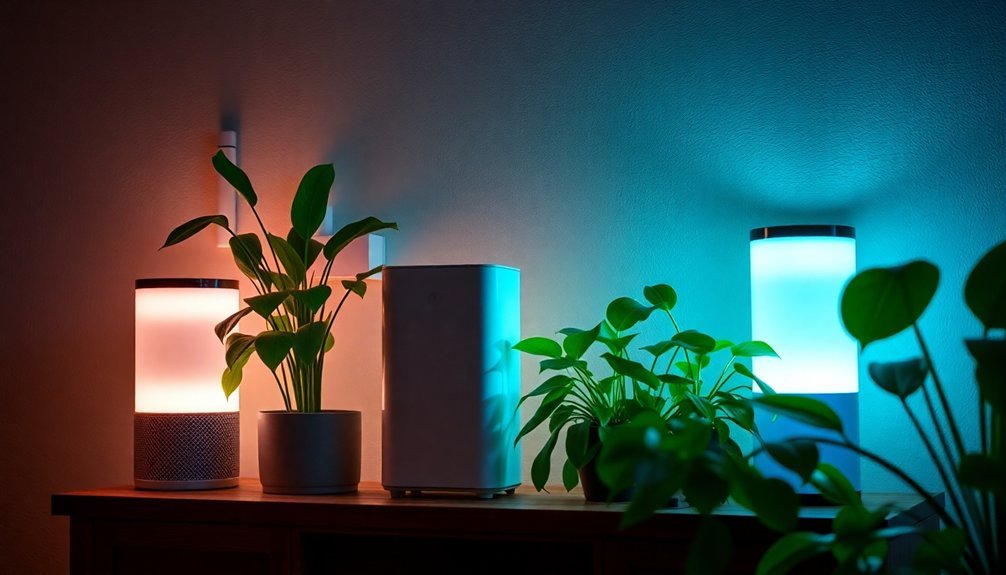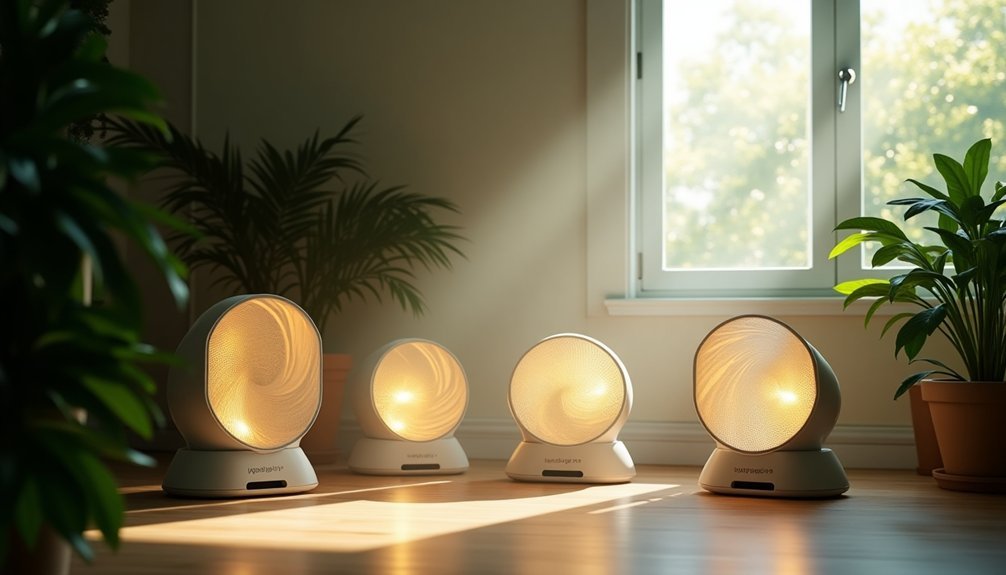You'll find five powerful air-purifying plants that thrive in low light: Snake Plants remove formaldehyde and benzene, Peace Lilies filter ammonia, ZZ Plants tackle xylene, Pothos absorbs carbon monoxide, and Chinese Evergreens clean formaldehyde from your air. These low-maintenance purifiers need minimal natural light and only occasional watering to keep your home's air fresh. Discover how strategic placement of these natural cleaners can transform your indoor air quality.
Essential Low-Light Plants for Indoor Air Quality

While maintaining indoor air quality can be challenging, several low-light plants excel at purifying the air without demanding bright sunlight.
You'll find that Snake plants and Peace lilies thrive in low light while effectively removing formaldehyde and other harmful toxins from your indoor environment.
For spaces with minimal natural light, ZZ plants and Pothos are excellent choices.
These resilient indoor plants improve indoor air quality by absorbing pollutants like benzene and xylene, with Pothos offering the added benefit of rapid growth.
Don't overlook the Chinese evergreen, which tackles both formaldehyde and benzene while requiring minimal maintenance.
All these plants serve as natural air purification systems, making them perfect for homes and offices where sunlight is limited but clean air remains a priority.
Top Air-Purifying Plants That Thrive in Shade
Building on nature's air-purifying capabilities, several shade-loving plants stand out as champions in improving indoor air quality. You'll find these air-purifying powerhouses thrive in low light conditions while effectively removing indoor air pollutants like formaldehyde.
| Plant Name | Light Needs | Toxins Removed |
|---|---|---|
| Snake Plant | Very Low | Formaldehyde, Benzene |
| Peace Lilies | Low to Medium | Ammonia, Benzene |
| ZZ Plant | Very Low | Xylene, Toluene |
Choose from easy to care options like Pothos, which excels at removing carbon monoxide, or Chinese Evergreen with its striking foliage and formaldehyde-filtering abilities. These plants don't just purify your air – they'll add natural beauty to any shaded space in your home. Each variety offers unique benefits while requiring minimal maintenance, making them perfect for both novice and experienced plant enthusiasts.
Bedrooms to Bathrooms: Placement Strategy for Air-Cleaning Plants

Strategic placement of air-purifying plants throughout your home maximizes their air-cleaning potential while complementing your living spaces.
Start by positioning Peace Lilies in your bathrooms, where they'll thrive in low light conditions while removing formaldehyde and benzene from the air.
In bedrooms, Snake Plants work overtime to improve air quality as you sleep, converting CO2 to oxygen at night.
For darker indoor spaces, rely on Chinese Evergreens and ZZ Plants, which require minimal light yet effectively clean the air.
These common houseplants are perfect for corners and shadowy spots.
Consider hanging Pothos in your bathroom or above sinks, letting their vines cascade while they filter pollutants.
Each air-purifying plant serves a specific purpose, making your home healthier room by room.
Maintenance Tips for Low-Light Plant Air Purifiers
Proper maintenance guarantees your low-light air purifiers thrive and clean effectively in dimmer spaces.
Keep your low-light air purifiers in peak condition through regular care, ensuring optimal air cleaning even in darker indoor environments.
These easy to grow plants require little attention, but following key care tips guarantees ideal air-cleaning performance.
Water infrequently, allowing plants like Snake Plants and ZZ Plants to dry completely between waterings. They tolerate low light conditions well, but you'll need to rotate your plants periodically to prevent uneven growth.
To boost their efficiency in cleaning the air, regularly wipe the leaves of Peace Lilies and Chinese Evergreens to remove dust buildup.
Monitor humidity levels, especially for moisture-loving varieties, and consider misting when needed.
Don't forget to fertilize low-light air purifiers every few months during growing season with a balanced houseplant fertilizer to maintain their health and air-purifying capabilities.
Creating Your Indoor Air Quality Garden in Limited Light

Despite limited natural light, you can create a thriving indoor air quality garden that both purifies your space and adds natural beauty.
Start by selecting air-purifying plants that thrive in dim environments, like Peace Lily and Chinese Evergreen. These powerhouse plants will actively remove toxins from the air while creating visual appeal in your indoor garden.
- Transform dark corners into vibrant, clean-air zones with the elegant Peace Lily's white blooms
- Let trailing Pothos create a cascading green waterfall while filtering harmful pollutants
- Add structure and modern appeal with the bold, upright Snake Plant
- Create depth and texture with Chinese Evergreen's striking variegated foliage
Position these low-light champions strategically throughout your space to maximize both their air-purifying benefits and aesthetic impact, turning your dim areas into rejuvenating, healthy living spaces.
Frequently Asked Questions
Which Indoor Plant Purifies the Air the Most?
You'll find the Peace Lily is your best air-purifying plant. It efficiently removes multiple toxins like ammonia, benzene, and formaldehyde from your indoor air, making it more effective than other common houseplants.
Which Indoor Plants Thrive in Low Light?
You'll find Snake Plants, Peace Lilies, ZZ Plants, Chinese Evergreens, and Pothos thrive in low-light conditions. These hardy plants won't just survive but flourish in darker spaces of your home.
What Plant Removes 78% of Airborne Mold?
The Boston Fern (Nephrolepis exaltata) is your best choice for removing airborne mold, as it'll filter out up to 78% of mold spores. You'll find it's especially effective in humid spaces like bathrooms.
How Many Plants Does NASA Recommend for Cleaner Air?
You'll need 15 to 18 houseplants in an average 1,800-square-foot home to effectively purify your indoor air, according to NASA's Clean Air Study. It's best to spread them throughout your living spaces.
In Summary
Start growing these five powerful air-purifying plants in your home's low-light spaces today. You'll breathe easier knowing they're working around the clock to clean your indoor air. Place them strategically throughout your home, maintain them with minimal effort, and enjoy the benefits of cleaner air. Remember, you don't need bright sunlight to create a natural air filtration system that works for your lifestyle.





Leave a Reply